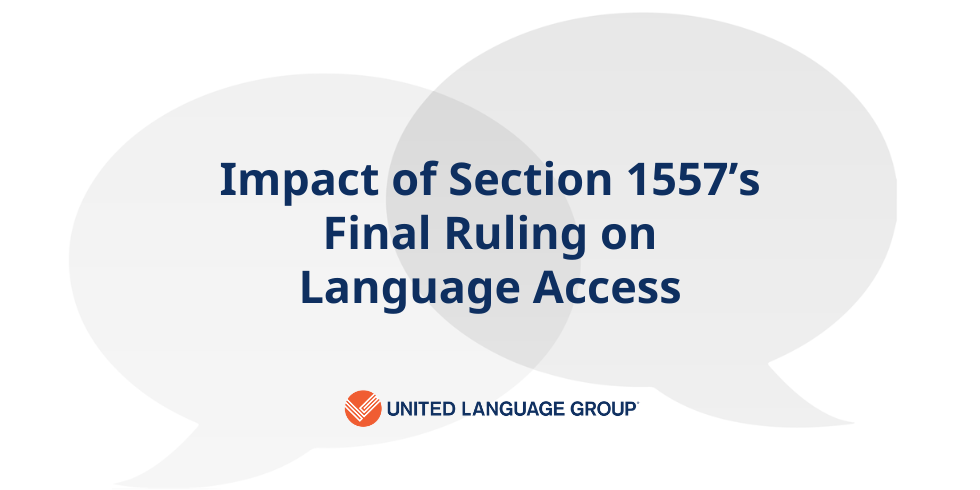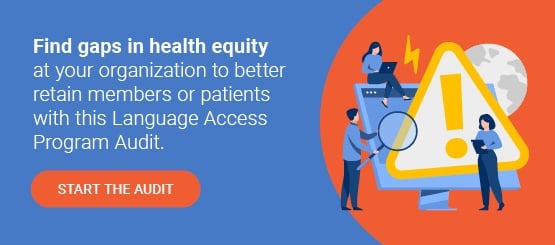With a focus on advancing health equity and reducing disparities in health care access, the Department of Health and Human Services (HHS) published a final rule in May 2024 to revise Section 1557 of the Affordable Care Act (ACA). Titled “Nondiscrimination in Health Programs and Activities,” the new rule aims to strengthen and reinstate protections from discrimination in any health program or activity receiving federal funding.
Containing several requirements designed to ensure all individuals can access healthcare free from discrimination, there are significant changes in terms of providing language assistance and accessibility services for individuals with limited English proficiency (LEP) as well as individuals with disabilities. As stated in the US Department of Health and Human Services Press Release dated April 26, 2024:
“Today’s rule is a giant step forward for this country toward a more equitable and inclusive health care system, and means that Americans across the country now have a clear way to act on their rights against discrimination when they go to the doctor, talk with their health plan, or engage with health programs run by HHS,” said Secretary Xavier Becerra
The latest requirements expand on the existing language access rules from the prior version of Section 1557, which is the legal ruling that prohibits federally funded health programs from discriminating based on race, color, national origin, sex, age, or disability. They provide additional measures to ensure that LEP individuals have meaningful access to covered health programs, and that language or ability doesn’t pose a barrier to receiving the best possible health outcome.
What do these updates mean for healthcare organizations, and how might it impact language access strategies moving forward? Here are notable considerations:
Effective Language Assistance Services
Providing accessible, accurate communications through qualified translators and interpreters is essential to advancing healthcare access and outcomes. Here’s an outline of how these services can be implemented according to the new standards:
- Use of Qualified Translators/Interpreters.
As documented throughout the Federal Registrar, there are considerable risks of adverse health outcomes due to misunderstandings or miscommunications using unqualified individuals in healthcare settings. Section 1557 includes requirements for covered entities to use only qualified Translators/Interpreters for each LEP individual eligible to be served or likely to be directly affected. There are also provisions prohibiting the reliance on unqualified individuals or untrained bilingual staff to interpret directly with LEP individuals.
- Telehealth Systems, Policies and Processes.
Telehealth can take place by video, phone, or other electronic means and is used by patients for anything from remote health care appointments to sending information to health care providers for review and analysis. Because of this, it’s vital that all entities subject to Section 1557 review their telehealth systems, policies, and processes, to ensure accessibility of their telehealth programs for anyone with disabilities and LEP.
- Utilization of Machine Translation.
In an innovative change, the final rule addresses approved use cases for incorporating Machine Translation (MT) into a covered entity’s communication strategy. As stated in the provisions, machine-translated text still must be reviewed by a human-qualified translator, particularly when the material is complex, non-literal or technical. With increasingly diverse language needs, rising volumes of content to translate, and new requirements to ensure effectiveness of LEP communication efforts, there are certainly opportunities to leverage MT into language access strategies. LSP’s help identify areas to measure and ensure the effectiveness of other critical communications for diverse audiences. If you’re curious about best practices for utilizing secure, compliant MT for healthcare, check out our recently published resource. - Accessibility of information for individuals with disabilities.
The final ruling declares that communications with individuals with disabilities must be as effective as communications with non-disabled individuals and must be provided in alternate formats. This can require that information be available not only in an individuals’ preferred language, but that auxiliary aids and formats such as large print, Braille, audio, and more are available. This is a growing need in pursuing equitable, accessible information and health outcomes and ULG has a great resource with tips for accessibility in healthcare here.
Utilizing Language Access Procedures to Expand Meaningful Access
Providing meaningful access has been an important part of Section 1557 and other language access initiatives, however the latest ruling contains several key updates:
- Overseeing language access procedures.
In a change from prior rulings, formal language access plans are no longer a requirement in the proposed provisions. Covered entities are to utilize language access procedures that support meaningful access and compliance. Organizations must also appoint a Section 1557 Coordinator that oversees the implementation and effectiveness of their language access procedures and must train all relevant staff in these procedures.
- Creating an effective language access procedure.
Covered entities must also ensure the effectiveness of their language access procedures. Among the items that HHS proposes covered entities should include:
-
- Instructions on how employees can obtain qualified translators/interpreters.
- Explanations of how employees identify LEP individuals.
- A list of translated materials and their locations.
This is not a comprehensive list and our team at ULG will make sure you implement everything you need for successful meaningful access. HHS points out that it is a covered entity’s “duty to translate beyond those documents that have already been translated at the time this list is made, and the list should be updated periodically.”
Providing qualified translation and interpretation services is integral to an effective language access procedure, but they are only the start to an effective program. True meaningful access that narrows the healthcare equity gap and improves outcomes also includes a deep understanding of each LEP individual eligible to be served or likely to be directly affected. This means increasing communication efforts beyond the standard set of documents to include cultural considerations, beliefs, preferred methods of communication, and even health literacy levels. Learn more critical considerations and the importance of cultural engagement to improve health equity in a recent blog entry by our team here.
This final rule will be broadly effective on July 5, 2024, giving covered entities six months to designate 1557 coordinators and a year to develop policies and procedures as well as notices of the availability of language assistance in applicable documents. Our team will continue to monitor these provisions as they change and come into effect. Our goal is to make compliance with Section 1557 as seamless and effective as possible so that your organization can ensure meaningful access for LEP individuals that you serve. Stay tuned for a road map to creating a plan for providing meaningful language assistance services. You can also contact us today to help implement your team’s healthcare communications.


